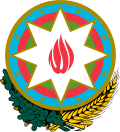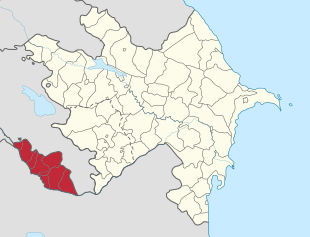Nakhchivan Autonomous Republic
| Naxçıvan Muxtar Respublikası | |||||
| Nakhchivan Autonomous Republic | |||||
|
|
|||||
| Motto : Azərbaycan! Azərbaycan! | |||||
| Official language | Azerbaijani | ||||
| Capital | Nakhchivan | ||||
| Form of government | Autonomous Republic | ||||
| Head of state | Vasif Talibov , Speaker of Parliament | ||||
| Head of government | Əlövsət Baxşıyev | ||||
| surface | 5500 km² | ||||
| population | 372,900 (2005) | ||||
| currency | Azerbaijan manat | ||||
| National anthem | Azərbaycan Marşı | ||||
The Autonomous Republic of Nakhichevan ( Azerbaijani Naxçıvan Muxtar Respublikası ) or Night Schiwan is an autonomous republic of Azerbaijan with 372,900 inhabitants (as of the 2005 census). It forms an exclave that is enclosed by Iran and Armenia as well as by a border section of only 17 kilometers from Turkey . The capital is the city of Naxçıvan , after which the autonomous republic is named. The exclave has its own constitution and parliament.
Surname
According to the founder of modern Armenian linguistics, Heinrich Hübschmann , the name "Nakhichevan" literally means "place of landing" and thus refers to the landing of Noah's ark on the nearby Mount Ararat . In ancient times it was also mentioned as "Naxcavan" ("avan" means "city" in Armenian) and by Ptolemy and other early geographers as "Naxuana", while medieval Arabic sources refer to it as "Nashava".
geography
Nakhichevan has an area of 5500 km² with a maximum extension of approx. 165 × 70 km. It is separated from the heartland by a corridor that is only 50 km wide and belongs to Armenia . In the north, Nakhichevan has an exclave with the village of Kərki itself. Since the war between Armenia and Azerbaijan , the most important traffic connections with the mother country have been through Iranian territory. The highest point of Nakhchivans is the Qapıcıq dağı in the Sangesurkamm with 3905 m height. The Ajozdsorski Mountains extend further to the west .
The administrative units of the autonomous republic are the Rajons ( Rayonlar ) Babək , Julfa , Kəngərli , Ordubad , Sədərək , Şahbuz and Şərur as well as the city of Nakhichevan .
Other large villages are Bananiyar , Nehram and Abragunis.
population
Most of the inhabitants are Azerbaijanis and belong to the Shiite branch of Islam . The large Armenian population gradually emigrated almost completely due to ongoing repression. As early as 1989 the proportion of Armenians in the population was only 1%. In the 1920s, up to a third of the residents were Armenians . According to estimates, the population in 2010 was around 403,000 people.
economy
The main line of business is agriculture , but there are also some ore deposits that are mined. The economy of the exclave is now very closely interwoven with neighboring Turkey, which is also due to the lack of connections to the rest of Azerbaijan.
The transport infrastructure is below average. There are hardly any connections to the mother country. Most of the traffic is done by road. There is one airport in Nakhchivan, Naxçıvan Airport .
history
The oldest finds in Nakhchivan date from the Neolithic . It was part of the early state of Urartu (Ararat) and from 521 BC. Part of the Armenian province in the empire of the Persians . From 189 BC It came to the Armenian Kingdom of the Artaxids , only to return to Persian rule as a result of the Sassanid invasion in the fourth century. The invasion of the Arabs in the seventh century was followed by a constant change of rulers ( Armenians , Seljuks , Mongols ) until Persia regained the upper hand over Nakhichevan in the 17th century.
The territory of the autonomous republic was, like much of the rest of Transcaucasia in 1828 in the Treaty of Turkmantschai of Persia to the Russian Empire ceded.
Nakhchivan in Soviet times
After the collapse of the tsarist empire in World War I , it was fought over between Azerbaijan and Armenia from 1918 to 1920 . The territorial dispute was finally resolved by Stalin as a political concession to Ataturk in favor of Azerbaijan after the Bolsheviks came to power in both countries . In 1921 the Turkish-Soviet treaties of Moscow and Kars established Nakhichevan's affiliation with Azerbaijan. Nakhichevan in its current borders became an autonomous area within Azerbaijan in 1921, and in 1924 it received the status of an Autonomous Soviet Socialist Republic . The Sangesur region , which separates Nakhichevan from the heartland of Azerbaijan, was recognized as part of Armenia at the same time, so that Nakhichevan became an exclave .
Together with Azerbaijan, Nakhichevan was now part of the USSR . The 1920s and 1930s were marked by the forced collectivization of agriculture , the nationalization of the few mines and industrial companies, expropriations, arbitrariness and tyranny. The remnants of feudal structures were eliminated. Soviet historiography also points to some achievements such as the fight against illiteracy, the expansion of schools and higher education, the establishment of research facilities, libraries and theaters.
During the Second World War , in which the Soviet Union was drawn from 1941–1945, the people of Nakhichevan also paid their tribute: they provided soldiers for the Red Army who fought on all fronts. Several thousand Nakhichevans received orders and medals, three fighters were honored with the honorary title " Hero of the Soviet Union " for their military services .
In the decades after the Second World War, Nakhchivan experienced a certain boom in economy (especially in the industrial sector) and culture by Soviet standards. Apparently it was particularly encouraged because the territory on the border with NATO member Turkey and temporarily pro-western Iran was of great strategic importance for the Soviet Union .
Upheaval and separation from the Soviet Union
The period of loosening and upheaval in the Gorbachev era (from 1988) resulted in Azerbaijan and Nakhichevan a. a. a reawakening of nationalism and increased tensions with Armenia. Nakhchivan was also affected by military clashes between Armenia and Azerbaijan, which were particularly evident in the Nagorno-Karabakh conflict .
Unrest broke out in Nakhchivan in December 1989 when its residents tore down the barricades built in the Soviet era on the border line with Iran and crossed the border to meet their Azerbaijani compatriots in northern Iran on the other side of the line. This action was discredited by the Soviet leadership and the Soviet media as an “outgrowth of Islamic fundamentalism ”.
In response to the protests in Baku, which the Azerbaijanis called " Black January ", which were bloodily suppressed by Soviet troops , the Supreme Soviet of the Nakhichevan ASSR published a declaration in January 1990 on the intended secession of Nakhchivan from the USSR , but not from Azerbaijan. Nakhichevan was, hardly known, the first region of the Soviet Union to declare (intended) independence just weeks before a similar action by Lithuania .
Heydər Əliyev's interim rule
After his demotion by Gorbachev, Heydər Əliyev found refuge in his native Nakhichevan in 1990. As the new chairman of the regional parliament, the Ali Məclisi, and at the same time head of the exclave (1990-1993), he gained a power base for his jump to Azerbaijan, where he served as president of the country for a decade (1993-2003). Since Əliyev's move to the capital Baku, Vasif Talibov held the position for him: since 1993 he has been head of Nakhichevan without interruption in his function as president of Ali Məclisi.
Vasif Talibov era
With the support of the President of Azerbaijan İlham Əliyev, who was related to him by marriage, Talibov knew how to stimulate the economic development of the exclave again. Dilapidated factories were closed or modernized with foreign investments. New businesses were established. Agriculture was promoted with the help of international organizations. Talibov also expects new perspectives for his country from the development of tourism , for which he sought investors and suggestions during a visit to Styria / Austria . With prestige objects in the sports sector like the Nakhchivan Stadium, he tries to cultivate his image vis-à-vis his population and also vis-à-vis abroad.
However, his regime is criticized by the opposition, human rights groups and international organizations for its extensive lack of rights, arbitrariness and violence as well as the extent of corruption . Several banks, including the newly founded “Nakhchivan Bank”, and extensive corporate holdings are controlled by him, his clan and his clientele. Nevertheless, Talibov knows how to promote himself and his region by receiving high-ranking visitors from all over the world and organizing international conferences. President Ilham Aliyev also endeavors at every opportunity to underline Nakhichevan's affiliation with Azerbaijan and his role as “his family's crown land”.
In contrast to Nagorno-Karabakh , Nakhichevan is not looking for independence, but is content with his intermediate status of a province and an autonomous subject with certain privileges. For example, President Talibov can act more independently than the government in Azerbaijan vis-à-vis the neighboring countries Turkey and Iran and also in some foreign policy issues.
In June 2018, the Azerbaijani military advanced into the neutral zone around Günnüt in northwest Nakhichevan, which had been abandoned since the Nagorno-Karabakh conflict . In the event of a conflict, the control of this high-altitude region would enable the important connecting road from the Armenian capital Yerevan to Stepanakert , the capital of the Armenian-occupied Nagorno-Karabakh region, to be blocked by artillery fire.
Guided tour of Nakhchivan (from November 1990)
- The presidents of Ali Məclisi (chiefs) Nakhichevans
- November 1990 - April 1991: Djalil Afijaddin Djalilow (August 1, 1946 - September 29, 1994)
- April 1991 - August 1991: Akper Fattach Aliyev (born April 26, 1950), also First Secretary of the Oblast Committee of the Communist Party of Azerbaijan
- September 5, 1991 - June 23, 1993: Heydər Əliyev (May 10, 1923 - December 12, 2003)
- July 3, 1993 - April 4, 1994: acting Vasif Talibov (born January 14, 1960)
- April 4, 1994 - December 16, 1995: Namiq Həsənov
- December 16, 1995 - present: Vasif Talibov
- Nakhchivan's premiers
- 1991–1993: Bedzhan Farzalijew
- 1993–2000: Shamsuddin Gusseynguli Chanbabajew (* 1939)
- 2000– : Əlövsət Baxşıyev (born June 22, 1956)
See also
- Nakhchivan Khanate
- History of Azerbaijan
- Azerbaijan (Iran)
- Nagorno-Karabakh : Comparable Ethnic Conflict Under Opposite Signs.
Web links
- Official website of the Nakhchivan Autonomous Republic
Individual evidence
- ↑ https://www.cia.gov/library/publications/the-world-factbook/geos/tu.html
- ↑ NOAH'S ARK: ITS FINAL BERTH ( Memento from March 12, 2008 in the Internet Archive )
- ↑ Article Autonomous Republic of Nakhchivan in the Great Soviet Encyclopedia (BSE) , 3rd edition 1969–1978 (Russian)
- ^ Hans-Joachim Hoppe : Nakhichevan - Outpost of Azerbaijan ( Memento from March 28, 2012 in the Internet Archive ), Eurasisches Magazin, August 2, 2011
- ↑ Xander Snyder: Azerbaijan Asserts Its Power in the South Caucasus. Geopolitical Futures, June 26, 2018. Retrieved June 28, 2018.
- ↑ http://www.worldstatesmen.org/Azerbaijan.html List of the heads of state of Azerbaijan and Nakhchivan
- ↑ НАХЧЫВАНСКАЯ АВТОНОМНАЯ РЕСПУБЛИКА г. Нахчыван ( Memento from December 27, 2010 in the Internet Archive ) Management of the Nakhchivan Autonomous Republic from 1990 to the present day
Coordinates: 39 ° 20 ' N , 45 ° 30' E






